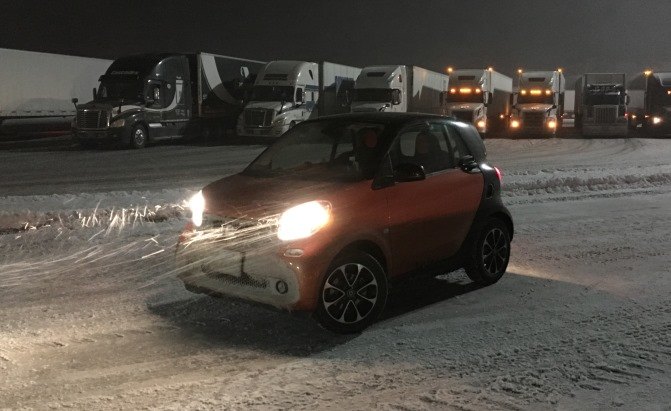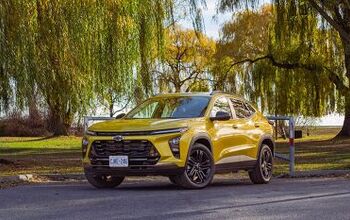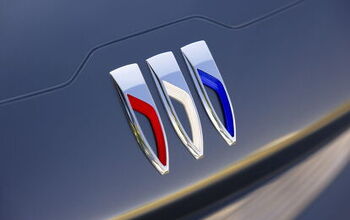We Took a 2016 Smart Fortwo on a Long-Distance Road Trip in a Snow Storm


FAST FACTS
| Engine: | 0.9 L turbocharged three-cylinder |
| Power: | 89 hp, 100 lb-ft. |
| Transmission: | Dual-clutch automatic transmission |
| EPA Fuel Economy: | 34 mpg city, 39mpg hwy, 34.6 mpg observed average |
| CAN Fuel Economy: | 7.5 L/100 km city, 6.1 L/100 km hwy, 6.8 L/100 km observed average |
| US Price: | Smart Fortwo Passion begins at $16,890 after destination charges, $19,170 as tested. |
| CAN Price: | Smart Fortwo Passion begins at $20,095 after destination charges, $21,390 as tested. |
It seemed like a good idea at the time.
The plan was to descend upon the North American International Auto Show piloting a 2016 Smart Fortwo. Designed as an inner-city runabout, the Fortwo is the perfect choice to navigate the tight parking garages of downtown Detroit. I’d be the maneuverability king of Motown. Just one minor detail though: I needed to drive it 240 miles from Toronto, Ontario, first. In a snow storm.
SEE ALSO: 2016 Smart Fortwo Review
It would be the ultimate adventure drive; heading across international borders to prove the new Fortwo is more comfortable, livable and most importantly, capable of enduring such a long-distance trek. And to up the ante on this saga, I’d be doing it in the middle of winter.

A Bigger, Better Fortwo
Knowing this wouldn’t be a cake walk, I was up for the challenge. I had faith in the revamped Fortwo that was redesigned from the ground up for 2016. At first look, it’s obvious the new Fortwo is a larger car. With a 3.9-inch wider track, the car has grown four inches in total width. It’s also taller now, up a half inch to 61.2 inches total, but overall length remains the same as the old model.
Under the cargo floor resides a new 0.9-liter turbocharged three-cylinder engine making 89 hp and 100 lb-ft of torque. That’s a healthy bump over the outgoing Smart Fortwo and is capable of propelling the car in a not-so-horrible 10.5 seconds from zero to 60 mph when equipped with the automatic transmission.
And that automatic transmission may be the biggest news of the Fortwo’s redesign. Thankfully, the old single-clutch five-speed semi-automatic transmission has been put out of its misery. It’s replaced by a choice of transmissions now, a salt-of-the-earth five-speed manual or a new six-speed dual-clutch automatic.

The Best Laid Plans…
On a sunny Friday afternoon, I set off to acquire my 2016 Smart Fortwo chariot. A bright orange mid-trim Passion model with an equally blazing orange interior, there’s no doubt they’ll see me rolling into the Motor City.
It turns out the much improved 2016 Fortwo is well, just that – much improved. Like award-winning most-improved-performer-of-the-year levels of improvement. My heart sank because all of a sudden, my tale of an epic road trip would turn out to be a normal drive.
The Fortwo is remarkable in how unremarkable and ordinary it is to drive. There are no quirks that dominated the old model. No bucking bronco transmission behavior, no darty steering and no sensation that I’m driving an oversized golf cart.
The extra width and new suspension setup makes the car much more stable at speed. It drives like many contemporary subcompact cars – not a freeway-fearing city car. I had planned an epic adventure story, but this was going to turn out as exciting as reading the terms and conditions of a smartphone update. It was just going to be me driving a six-hour round trip, drama-free in a car that is suddenly perfectly at home on the highway.

Ominous Forecast
Sunday, January 10 arrived, and it was time to head out on my expedition to Detroit. The weather report looked daunting, as the current 43F temperatures and rain were to turn into 28F and snow before my odyssey would come to an end. Friends, colleagues and acquaintances who had left earlier in the day were reporting that things were indeed turning sour as they approached Detroit. I decided it was time to hit the road.
With a car as small as the Fortwo, cargo capacity is never going to be great. But the 9.2 cubic feet of space did swallow my carry-on suitcase, garment bag, computer bag and camera equipment with ease. The passenger compartment is spacious and airy, thanks in part to the optional see-through plastic roof.
The first hour of my journey, before all hell broke loose, I had time to reflect on the 2016 Fortwo. I began to notice just how high the seating position is, which made me wonder if maybe Smart should call it the ForCrossover. The driver is perched up above regular cars and is eyeball to eyeball with minivans and crossovers.
Another early observation is how much improved ride comfort is. Smart has increased the spring travel at all four corners and has given the Fortwo higher sidewall tires for a softer ride. But the company hasn’t forgotten about those who want a little performance in their Smart, as there is an optional sports suspension with stiffer springs and a 10 mm lower ride height.

A Lamb of a Drive Turns into a Lion
It was the second hour of my drive when I was slapped in the face by a weather bomb. The weather everyone had been talking about had finally hit. Within minutes, the outside temperature dropped over a dozen degrees and the rain-soaked roads began to flash freeze. Rain turned to ice, then quickly into snow.
SEE ALSO: 2016 Smart Fortwo Cabrio Unveiled, Makes Debut at Frankfurt Motor Show
But none of this was much concern, as my Fortwo was equipped with proper winter tires and I have decades of experience driving in such conditions. It was another weather phenomenon that began to wreak havoc with me – the wind. It was blowing at an offset three-quarter angle with gusts approaching 53 mph.

Blown Away
For any car, that’s a serious gust, but for me in a small, high-riding box that weighs a mere 2,053 pounds, it was menacing. My land speed caries at this point between 50 and 70 mph depending on how much ice is coating the roadway. When I’m driving through a tree-lined corridor or a wide-open field, it’s not too bad, as the wind is constant and I can drive accordingly.
It’s when I leave the protection of the trees or pass a big rig that things get dicey. A wall of wind hammers me, making the Fortwo suddenly feel like it’s going 110 mph instead of 60 mph. Since the car is limited to a top speed of 96 mph, strange things occur when the combined wind speed enters into triple digit figures.
The pillar-less door is no match for the pressure these wind speeds create, and the driver’s window begins to get sucked away from the rubber seal. This leaves a small opening that creates an ear-piercing shriek. It’s so intense at times that I lower the window slightly to break the vacuum. As soon as the combined wind speed drops below 100 mph, everything is fine again, so unless you live an area prone to Gale force winds, this issue will probably never creep up.

But Safety is Key
As much as the wind huffed and puffed, I never came close to losing control of the Smart, despite my ever whitening knuckles. This can be attributed to the well-engineered design of the Fortwo as much as its standard crosswind assist feature. When the car senses it’s about to drift off track due to a high crosswind, it intervenes with braking and throttle manipulation to ensure the Smart keeps in a straight path. It’s automatically enabled at speeds of 50 mph and above and as much as I like to think I was one the expertly counter steering the Fortwo in the severe crosswinds, I could feel the assist kick in a few times.
And if things did go awry, the Fortwo is built to keep occupants safe. The passenger compartment is surrounded by a tridion cell that performed as well in frontal crash tests as the Mercedes-Benz S-Class. It also comes standard with eight airbags and can be had with forward collision warning.

Smart Fortwo – 1, Mother Nature – 0
After a five-hour trip, I arrived at my destination. The Fortwo was finally in its element, ripping around the city streets of Detroit wearing a thick layer of road grime like a badge of honor. Parking was hilariously easy with the Smart, as its generous sightlines and small dimensions make it child’s play to slot into virtually any spot.
Part of this maneuverability is courtesy of an amazingly small 22.8 foot turning radius. Upon exiting the Auto Show one evening, a colleague had to carefully navigate his borrowed luxury yacht out of a cramped parking spot. I, on the other hand, quickly freed the Fortwo and proceeded to perform complete 360-degree turns within the parking garage’s corridor in a display of showboating and real-world mobility.

And Then the Trip Home
After three hard days covering the North American International Auto Show, I looked forward to a drama-free drive home in the Fortwo – a car charming its way into my heart. Of course, a simple drive home was not in the cards, and about halfway to my sweet, comfortable bed, I encountered a lake effect snow squall.
The freeway quickly became a seemingly endless field of white with no discernible point between pavement and gravel shoulder. Following a fellow auto writer in large, all-wheel-drive sedan, we blazed a trail through the fresh powder.
After nearly two hours of trudging through the ever growing accumulation, I was coming to the conclusion that the Fortwo is more reassuring in moderate snow than high winds. It has a sure-footed stability the old Smart car lacked. There’s a certain juvenile satisfaction of passing pickup trucks and crossovers on a snow-laced highway in a Smart car. Deeper snow ruts can wreak havoc with the Fortwo and try to kick the back end out, but stability control and careful driving will always bring it back in line.

Watch the Fuel
It’s important that anyone taking the Fortwo on a long distance trip to keep an eye on the fuel. There’s no fuel range gauge on the Smart and with just a 7.7-gallon tank, a lot of stops for premium fuel will need to be made, so plan carefully.
SEE ALSO: 2013 smart electric drive Review
During my near 500 miles of travelling, I averaged 34.6 mpg, which is a bit low compared to the Fortwo automatic’s official rating of 39 mpg on the highway. But I was fighting a severe headwind for a good portion of the trip and then spent a few hours inefficiently slipping and braking the drive wheels during a snow storm.

The Verdict: 2016 Smart Fortwo Long Distance Road Trip
Is the Smart Fortwo the perfect long distance car? No, not even close. It doesn’t even make the short list. But it’s much better than it used to be. I encountered two of the worst storms I’ve driven through in years and neither could stop the Fortwo. If the Smart can make it through conditions like these, then it can handle virtually anything. An already fantastic car in the city, the Smart Fortwo can now also handle the odd long distance jaunt when needed.
Discuss this story on our Smart Fortwo forum
LOVE IT
- Turning radius
- Spacious interior for its size
- Improved transmission
- Improved ride comfort
LEAVE IT
- Fuel economy
- Small fuel tank
- Extreme crosswinds cause window shriek

A 20+ year industry veteran, Mike rejoins the AutoGuide team as the Managing Editor. He started his career at a young age working at dealerships, car rentals, and used car advertisers. He then found his true passion, automotive writing. After contributing to multiple websites for several years, he spent the next six years working at the head office of an automotive OEM, before returning back to the field he loves. He is a member of the Automobile Journalists Association of Canada (AJAC), and Midwest Automotive Media Association (MAMA). He's the recipient of a feature writing of the year award and multiple video of the year awards.
More by Mike Schlee































Comments
Join the conversation
I need to find a translation gizmo I can download on the Internet!
I can confirm, the Smart ForTwo is an epic vehicle. I purchased in January 2021 during lockdown as a short term solution to being car-less but also considering if I needed such high outgoings now life had changed so much. Fast forward over two years and Polly Pocket and I are still out on road trips, running around town. She's a legend!